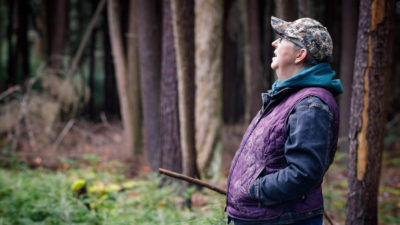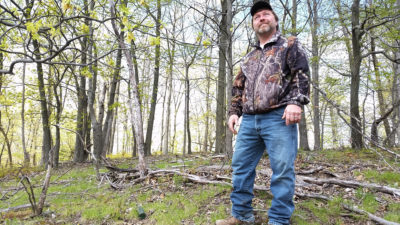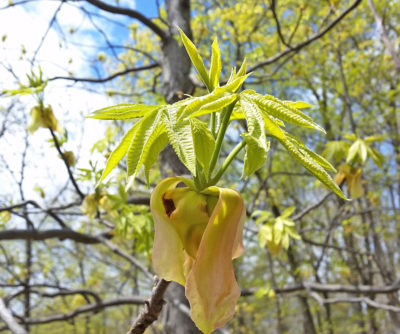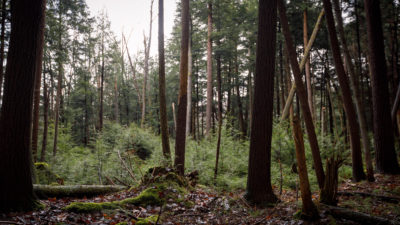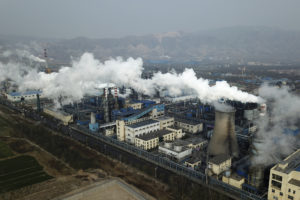Tim Leiby had wrapped up a fun but fruitless early-morning turkey hunt and was enjoying an old John Wayne flick when I arrived at Willow Lodge near Blain, Pennsylvania. A few flurries drifted down on this unseasonably cold May morning. After a quick scan of antlers mounted on virtually every wall of the cozy hunting lodge, we headed out for a socially distanced stroll through what Leiby calls “our little piece of heaven.”
这个在宾夕法尼亚州中南部的山脊和瓦利国家的占地95英亩,是八个家庭共同拥有的狩猎和远足避难所。尽管他喜欢它,但莱比(Leiby)知道它会更好。在1980年代,森林仍在从重型伐木中恢复过来,它充满了侵入性或不必要的植物 - 他指出了条纹枫树,公主树和牛bar-对野生动植物无济于事,并防止了橡树和山胡桃等所需的硬木。莱比说:“秃鹰在这里是一个可怕的侵入性。”“它正在窒息地面盖。”
Small family-owned forests like this one make up 38 percent of U.S. forests — together more than 1.5 times the area of Texas, and more than any other ownership type. While most owners want to do right by their land, they rarely have access to the needed expertise or resources. That, however, may be changing. In April, the environmental nonprofits The Nature Conservancy (TNC), American Forest Foundation (AFF), and Vermont Land Trust announced two new programs, powered by a $10-million rocket boost from the tech giant Amazon, to funnel funds from carbon emitters to small landowners like Leiby eager to grow larger, healthier forests.
计划负责人估计,如果规模高达400万英亩的家族林(比康涅狄格州稍大),该计划可能会抵消到2031年的1850万吨碳排放。如果这些项目达到了签署美国20%的最终目标forest landowners, forests could sequester up to 2 billion tons between 2030 and 2100. That’s not going to save the climate — in 2018 alone, the U.S. emitted 5.4 billion metric tons of carbon dioxide — but it could make a dent, roughly like taking 6 million cars off the road for seven decades.
Families “own more forest land across America than another other group, even more than the federal government.”
最近的公告还代表了亚马逊将如何在去年秋天宣布的1亿美元中的一些提示,即有很多大张旗鼓和一些细节,它将致力于基于自然的气候解决方案。专家说,它可以打开大门,使家庭森林所有者摆脱距离,并与全球气候变化进行斗争。
明尼苏达大学林业教授迈克·基尔戈尔(Mike Kilgore)说:“这是我第一次试图捕捉大量森林所有者的份额。”
Climate experts rank sequestration and storage of carbon in trees, which are about half carbon by weight, as among the most affordable and scalable natural climate solutions. A 2017 study found that such solutions, if implemented globally, could provide近期气候变化的三分之一以上needed to meet the targets spelled out in the 2015 Paris Agreement. U.S. forests are especially potent carbon sinks because almost all of them are recovering from logging. The U.S. Forest Service says thatthe nation’s forests absorb almost 16 percent of the country’s carbon emissions。
Yet few forests are managed optimally for carbon sequestration. Today, throughout much private forestland, fast logging rotations, “high-grading” that strips out the largest, most valuable trees, and rampant invasive species compromise forests’ ability to pack on carbon and keep it locked away. It’s not that small landowners don’t care about trees or biodiversity — survey after survey finds that they do, passionately. But few have forestry expertise or hire professionals to help with sustainable management, according to Forest Service research.
Tim Leiby co-owns his 95-acre forest near Blain, Pennsylvania with eight other families.Gabriel Popkin / Yale E360
这是一个问题,因为“家庭森林所有者统治”,布雷特·巴特勒(Brett Butler)National Woodland Owner Survey。“他们在美国拥有的森林土地比其他其他团体更多,甚至比联邦政府更多。”
Environmental groups have sought to direct payments from donors and polluting companies to forest owners in exchange for improved management that boosts carbon storage. To establish credibility, such programs must rigorously measure the sequestered carbon. So far, payments have gone mainly to land trusts, public forest owners, or even to entire tropical states or countries, where large forests can sequester enough carbon to justify monitoring, reporting, and verification expenses.
对于大多数所有者来说,对于家庭森林所有者而言,碳市场仅提供少量付款和所需的合同条款,这些条款对大多数所有者来说太繁重,他们强烈重视隐私和不喜欢其土地上的长期限制,这是根据Marla Markowski-Lindsay和Paul Catanzaro的说法。家庭森林研究中心在马萨诸塞州阿默斯特。他们对马萨诸塞州森林所有者进行的一项调查发现,与该国其他地方进行的调查一致,几乎没有参与现有的碳市场。Markowski-Lindsay说:“我们发现了兴趣,但似乎有一些障碍。”
乔什·帕里什(Josh Parrish)说:“小型家庭森林所有者几乎不可能参加碳市场。”TNC的工作林地计划,将2,000英亩以上森林的所有者连接到此类市场。“这很复杂且昂贵。”为了将家庭森林所有者带入折叠状态,帕里什(Parrish)和他的同事“很快意识到,我们必须要低得多,而且更有效,但仍然保持围绕森林碳测量和森林碳验证的科学严谨性。”
家庭森林计划由科技巨头亚马逊资助,该计划与自然保护协会建立了1亿美元的合作伙伴关系。
去年秋天,这项努力得到了很大的推动。经过多年抵抗对气候变化采取行动的多年后,在线零售商亚马逊在9月突然扭转了课程并宣布与TNC建立了1亿美元的合作伙伴关系实施自然气候解决方案。这些解决方案仍然需要弄清楚。TNC的工作人员告诉科技巨头,他们相信他们可以打破家庭森林logjam,并让成千上万的夫妻地所有者进入碳游戏。诀窍是要向土地所有者支付土地所有者的额外碳,如果他们采用了两种公认的可持续林业实践中的一种或两种:在收获前更长的森林种植,并去除侵入性植物和与之竞争的小树木,并与之竞争并紧张较大的树木。4月,自然保护协会,美国森林基金会和亚马逊宣布开幕Family Forest Carbon Program给土地所有者;TNC和亚马逊还支持佛蒙特州的较小伴侣计划。
该计划将涵盖每种惯例的大部分费用,并为咨询林务员支付,以帮助每个土地所有者制定一项可持续的管理计划,旨在增强碳储存量,还可以增强野生动植物,水质和其他森林土地所有者重视的生态系统服务。莱比(Leiby)签署了一项合同,该合同将赔偿他的放弃未来收入的收获,并允许树木成熟。他希望现金和专业建议还可以帮助他管理入侵物种并吸引更多的野生动植物。
与以前需要长达99年合同的计划不同,家庭森林碳计划仅承诺土地所有者10到20年。计划负责人开发了会计方法,该方法模拟了在两种可持续林业实践下如何改变碳量,并通过比较累积在注册森林样本上的碳与不采用这些实践的对照地块的碳来验证收益。根据AFF的数据,这些方法应大部分消除对地面森林库存的需求,这些清单可能会花费每个站点花费数千美元,从而将监视和验证成本削减四分之三。
重要的是,计划设计师说,增强碳的实践也有望增加生物多样性和木材价值,从理论上讲,这是家庭森林碳计划,这是环保主义者寻求的双赢的经典例子。188金博网注册就送188TNC森林碳科学家彼得·埃利斯(Peter Ellis)说:“这两种实践不仅在景观中存储更多的碳,而且至少从长远来看,它们还可以更可持续地产生更多的木材。”“如果您推迟收获,实际上您可以在接下来的100年中获得更多更高质量的木材。”
尽管如此,典型的土地所有者不会从该计划中获得意外收获。根据AFF提供的数据,招募100英亩森林的人(这是美国典型的小土地所有权)将在该计划中赚取约20年的24,500美元。一旦树木成熟后,收获可能会增加可比的数量。大多数森林所有者都从他们的土地上收获树木,尽管频率和强度不同。
The modest return doesn’t bother Susan Benedict, who along with her brothers is enrolling some of the land they own near State College, Pennsylvania in the program. She and her siblings don’t need their forest to turn a profit; she just doesn’t want to lose money by forgoing a timber harvest to allow trees to grow larger. “My goal is to develop income streams that will for sure take care of the taxes” she pays on the land, she says. “As long as we can pay the taxes, we can keep it.”
该计划的批评者认为,碳市场使公司无法实际减少其排放。
莱比的优先清单也很低;他说,他“不知道”他可以从家庭森林碳计划中赚多少钱。“最重要的是,我的孩子们有一个健康,可持续的森林,希望有一天我的孙子孙女。”
我与之交谈的大多数外部专家都说,该计划的设计应该避免一些绊脚石过去关闭了土地所有者。但是,他们警告说,招募成千上万拥有数百万英亩土地的人将是一项艰巨的任务。
家庭森林研究中心的Catanzaro说,这项20年的合同是很长的时间。“这是一个不错的平衡” - 足够长的时间,足以获得真正的碳的收益,并且短短,以至于没有使土地所有者感到束缚。
森林服务局的管家说:“将会有一些土地所有者对此非常感兴趣。”“但是有多少英亩,他们拥有多少英亩 - 这将非常有趣。”
并非环保社区中的每个人都在船上。倡导小组的保护科学家萨姆·戴维斯(Sam Davis)山茱wood联盟, says carbon markets can disincentivize companies from actually reducing their emissions. Such markets also funnel money to landowners who are, if not rich, at least well-enough off to own land, rather than to low-income communities that are often most harmed by industrial pollution, Davis says. “Carbon markets tend to act as a license to pollute,” he says.
4月,TNC和AFF开始签署土地所有者。几乎立即,冠状病毒大流行迫使他们停下来。这些组织为临时访问开发了一项社会固定协议,并谨慎地重新开放了注册。在这个初始的飞行员阶段,他们的目标是签署100名宾夕法尼亚州土地所有者,拥有8,500英亩的土地,能够隔离195,000吨碳。纠结后,计划负责人希望开始在全国各地招募森林所有者。
除了亚马逊外,包括国际报纸在内的公司;Domtar,纸浆和造纸机;3M支持该计划的建设,尽管每个人投入多少钱不是公开的。亚马逊已承诺730万美元来支持家庭森林碳计划,包括在飞行员阶段支付监控和验证费用;1000万美元的其余部分将支持佛蒙特州计划。它还承诺购买两个计划产生的500万美元的碳信用额。亚马逊可持续性负责人卡拉·赫斯特(Kara Hurst)表示,这家科技巨头的角色不是无限期地支持这些计划,而是利用其可见性和市场能力来“催化”碳偏移量的市场,最终可以支持这一碳偏移市场。她说:“向市场有很多很好的信号传播,这是人们想要的。”
After wrapping up my tour of Leiby’s woods, I drove down the road to what the TNC’s Parrish half-jokingly calls the “Parrish experimental forest” — a 200-acre woods he and his wife own. As we hiked down old logging roads, he pointed out places where he’d created gaps now filled with beech, hickory, and oak seedlings, while overhead the tallest trees soared to greater heights. Elsewhere were logs that he’d felled carefully to avoid damaging other trees. These are the kinds of practices he hopes the family forest program will spread across the Appalachians and beyond.
他说:“在一个管理良好的森林中,甚至看起来都没有砍树。”
